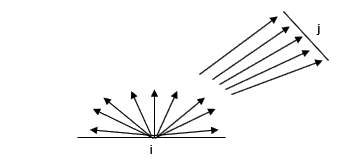View factor calculation using the Monte Carlo method
The thermal solver uses the CPU-based Monte Carlo algorithm for calculating view factors in radiation modeling using ray-tracing technique when modeling advanced optical properties.
The Monte Carlo method, a ray-casting or ray-tracing technique, is a statistical approach that uses random sampling to estimate radiative exchange in an enclosure.
To determine the view factor from the surface element i to the element j, rays are randomly launched from the element i. The view factor Fij is then estimated as the fraction of rays that strike the element j:

The Monte Carlo method evaluates radiative exchange by simulating the emission of rays from sources defined across the solar and infrared spectra. These rays are traced through the environment until they are absorbed, diffusely reflected, specularly reflected, or transmitted, capturing the full range of radiative interactions.
To compute view factors, this method gathers statistical data from the points where rays intersect with surface elements, enabling accurate geometric characterization of radiative exchange between surfaces.
A uniform random seed is applied across all elements in the simulation. This ensures that each element uses the same initial random sequence, promoting consistency and reproducibility in the results.
This method also directly determines radiative couplings and thermal loads by launching ray packets, representing discrete photon bundles, from emitting surfaces in randomized directions. These packets are tracked until they are absorbed or otherwise extinguished, and their interactions with surfaces are analyzed to quantify energy transfer.
This approach is particularly effective for modeling radiative heat exchange in systems with complex surface behaviors, including angle-dependent reflection and emission. It also supports the simulation of radiation transport within participating media, accounting for absorption, emission, and scattering within the medium itself.
While the Monte Carlo method is particularly useful for modeling advanced optical properties, such as specular reflection, and wavelength-dependent behavior, it is generally less efficient and less accurate than deterministic methods or the hemicube method when applied to enclosures with simple diffuse emission and reflection properties.
Application
Use this method when:
- Partial illumination effects significantly impact the thermal analysis.
- The model includes complex reflection functions such as bidirectional reflectance distribution functions (BRDFs) and scattering in participating media.
